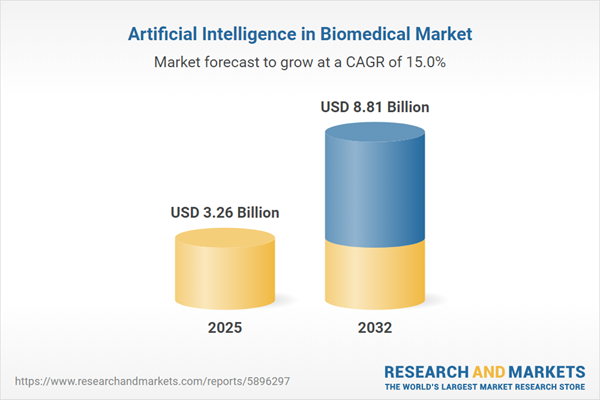Speak directly to the analyst to clarify any post sales queries you may have.
The artificial intelligence in biomedical market is rapidly transforming research and clinical pathways through enhanced data insights, operational streamlining, and new models for precision patient care. Sophisticated AI technologies are now central to evolving diagnostics and therapeutic strategies across the life sciences sector.
Market Snapshot: Artificial Intelligence in Biomedical Market Growth and Outlook
The Artificial Intelligence in Biomedical Market grew from USD 2.87 billion in 2024 to USD 3.26 billion in 2025. It is expected to continue growing at a CAGR of 15.03%, reaching USD 8.81 billion by 2032. This growth highlights the increasing reliance on AI-driven solutions for research acceleration, early disease detection, and next-generation therapeutics within the biomedical field. Adoption rates are driven by innovation in algorithms and data infrastructure, as well as a rise in collaborative ventures between technology vendors and healthcare experts.
Scope & Segmentation: Core Areas Driving Market Evolution
- Component: Hardware (including memory, network devices, and processors); Services (consulting, implementation, integration, maintenance); Software (applications, middleware, and platforms).
- Technology: Computer vision (facial, image, and pattern recognition); Machine learning (deep, reinforcement, supervised, unsupervised learning); Natural language processing (chatbots, language translation, speech recognition, text analysis); Robotic process automation (attended and unattended).
- Business Function: Customer service (feedback analysis, personalized support), Finance (fraud detection, risk management), and Operations (process optimization, resource allocation).
- Application: Clinical trials (data analysis, recruitment), Diagnostics (pathology, radiology), Patient monitoring (remote and wearable devices), Therapeutics (drug discovery, precision medicine).
- End User: Academic and research institutes (universities, research centers), Government agencies (public health organizations, regulatory bodies), Healthcare providers (clinics, hospitals), Pharmaceutical companies (biotech, medtech firms).
- Deployment Mode: Cloud-based (hybrid, private, public) and on-premise.
- Regional Scope: Americas (North America and Latin America), Europe, Middle East & Africa, and Asia-Pacific.
- Key Companies Covered: AiCure, LLC; Arterys Inc.; Aspen Technology Inc; Atomwise Inc; Augmedix, Inc.; Behold.ai Technologies Limited; BenevolentAI SA; BioSymetrics Inc.; BPGbio Inc.; Butterfly Network, Inc.; Caption Health, Inc. by GE Healthcare; Cloud Pharmaceuticals, Inc.; CloudMedX Inc.; Corti ApS; Cyclica Inc by Recursion Pharmaceuticals, Inc.; Deargen Inc; Deep Genomics Incorporated; Euretos BV; Exscientia plc; Google, LLC by Alphabet, Inc.; Insilico Medicine; Intel Corporation; International Business Machines Corporation; InveniAI LLC; Isomorphic Labs; Novo Nordisk A/S; Sanofi SA; Turbine Ltd.; Viseven Europe OU; XtalPi Inc.
Key Takeaways for Senior Decision-Makers
- AI is redefining biomedical research and practice, powering more agile discovery cycles and enabling advanced patient monitoring with data-driven precision.
- Stakeholders are adopting automated tools and integrating AI into legacy workflows to streamline diagnostics, optimize operational resources, and improve care outcomes.
- Collaboration across domains—including life sciences, technology, and regulatory expertise—is accelerating innovation while managing the sector’s rigorous compliance demands.
- Regional strategies reflect local digital health readiness, policy frameworks, and academic capabilities, driving varied adoption paces across global markets.
- Vendor landscape is characterized by an active mix of established technology leaders and agile startups delivering solutions that support everything from drug discovery to clinical decision support systems.
Tariff Impact: Navigating US Market Disruption
New US tariffs on AI hardware and specialized software have increased costs for biomedical organizations, resulting in a reassessment of supply chains and an emphasis on local sourcing. Service providers are adapting to tighter margins by improving process efficiency and expanding remote advisory services. This environment is giving rise to new consultative roles for compliance, while leading software vendors restructure pricing and adopt modular deployment models to counteract tariff-driven pressures.
Research Methodology & Data Sources
This report combines extensive secondary analysis of peer-reviewed publications, patents, regulatory filings, and industry white papers with structured primary interviews. Engagements with executives, R&D leaders, and key innovators ensured in-depth validation of trends and segment performance. Advanced analytics and scenario modeling contributed to a balanced and accurate evidence base for actionable strategy recommendations.
Why This Report Matters for Strategic Leaders
- Guides resource allocation and partnership decisions based on proven AI adoption patterns and emerging industry standards.
- Helps navigate evolving compliance and risk scenarios, especially in regions or market segments facing regulatory or supply chain disruption.
- Supports ROI-driven adoption of biomedical AI through clear analysis of market segmentation, deployment models, and leading solution providers.
Conclusion
Decision-makers face a rapidly evolving environment in biomedical AI. Leveraging robust research, this report provides practical insights to drive data-driven strategy, operational excellence, and sustained innovation across the global healthcare landscape.
Additional Product Information:
- Purchase of this report includes 1 year online access with quarterly updates.
- This report can be updated on request. Please contact our Customer Experience team using the Ask a Question widget on our website.
Table of Contents
3. Executive Summary
4. Market Overview
7. Cumulative Impact of Artificial Intelligence 2025
Companies Mentioned
The companies profiled in this Artificial Intelligence in Biomedical market report include:- AiCure, LLC
- Arterys Inc.
- Aspen Technology Inc
- Atomwise Inc
- Augmedix, Inc.
- Behold.ai Technologies Limited
- BenevolentAI SA
- BioSymetrics Inc.
- BPGbio Inc.
- Butterfly Network, Inc.
- Caption Health, Inc. by GE Healthcare
- Cloud Pharmaceuticals, Inc.
- CloudMedX Inc.
- Corti ApS
- Cyclica Inc by Recursion Pharmaceuticals, Inc.
- Deargen Inc
- Deep Genomics Incorporated
- Euretos BV
- Exscientia plc
- Google, LLC by Alphabet, Inc.
- Insilico Medicine
- Intel Corporation
- International Business Machines Corporation
- InveniAI LLC
- Isomorphic Labs
- Novo Nordisk A/S
- Sanofi SA
- Turbine Ltd.
- Viseven Europe OU
- XtalPi Inc.
Table Information
| Report Attribute | Details |
|---|---|
| No. of Pages | 186 |
| Published | November 2025 |
| Forecast Period | 2025 - 2032 |
| Estimated Market Value ( USD | $ 3.26 Billion |
| Forecasted Market Value ( USD | $ 8.81 Billion |
| Compound Annual Growth Rate | 15.0% |
| Regions Covered | Global |
| No. of Companies Mentioned | 31 |









